4 High-end PCIe SSD drives tested for your next DIY PC
Note: This article was first published on 19th February 2016. All of the drives compared are still the best available from each brand at the time of re-publication.
Why PCIe?
We have said it many times before, but it bears mentioning it again. If you are still using a mechanical hard disk drive as your primary drive, upgrading to an SSD will net you the biggest performance gains. The reason is because even the slowest SSD will run rings around the fastest 10,000rpm hard disk drives. For proof, check out our review of the Western Digital VelociRaptor drive. Furthermore, SSD prices are at an all-time low, so there really is no reason for anyone to still be dawdling along with a mechanical hard disk drive.
That said, even SSDs todays are hampered by the limiting SATA interface. The current iteration of the SATA interface, known as SATA III or SATA 6Gbps, offers, as its name suggests, 6Gbps of bandwidth. After taking encoding inefficiencies into account, this works out to around 4.8Gbps or 600MB/s. Now if you look at the sequential read and write speeds of SATA-based SSDs, you’ll find that a great number of them top out at these speeds, clearly showing that the interface is the limiting factor.
What next then? The answer is obviously the PCIe interface. The PCIe interface, now into its third revision, offers 8 GT/s or roughly 984MB/s of bandwidth per lane. What this means is that the latest consumer PCIe-based SSDs that support PCIe 3.0 x4 would be able to enjoy a maximum bandwidth of a whopping 32GT/s or just about 4GB/s - 6 times greater than that of SATA 6Gbps.
But PCIe aside, the other improvement that’s allowing SSD’s to perform at their maximum potential is the new NVMe protocol. NVMe or Non-Volatile Memory Express was developed expressly for PCIe-based SSDs, and supersedes the old AHCI protocol that was optimized for HDDs, with the goal of improving storage performance. To do so, NVMe allows for more commands per queue and also more queues, to take advantage of the extremely low latency of flash-based storage.
So today, we are going to explore the PCIe-based SSDs that are available right in the market right now.
The Samsung SSD 950 Pro
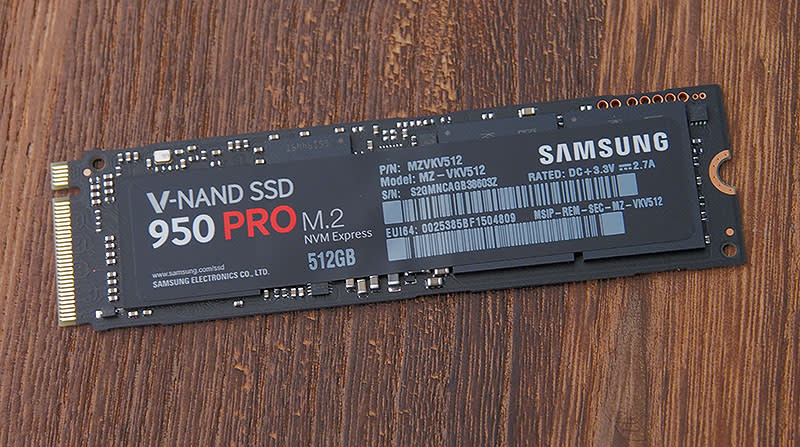
We begin with a familiar figure, the Samsung SSD 950 Pro, the reigning SSD speed king in our labs. We first tested it here and then explored its performance further by unleashing its full potential using a PCIe 3.0 x4 to M.2 adapter.
We urge you to read these two features first to better understand the drive. But the gist is this, the SSD 950 Pro is Samsung’s fastest consumer drive yet. Thanks to the speedy PCIe 3.0 x4 interface, support for the new NVMe protocol that was developed expressly for fast flash drives, and Samsung’s own V-NAND, the SSD 950 Pro racked up the highest performance figures we have ever seen in our history of testing SSDs.
Performance aside, it also comes with a high endurance rating, support for hardware encryption, and Samsung’s easy-to-use Magician software for monitoring and maintaining the drive. Overall, it’s an easy drive to recommend to serious enthusiast because of its blend of performance, endurance, and features. But how would it fare when pitted against other PCIe-based SSDs? Well, that’s what we are here to find out.
Intel SSD 750 Series
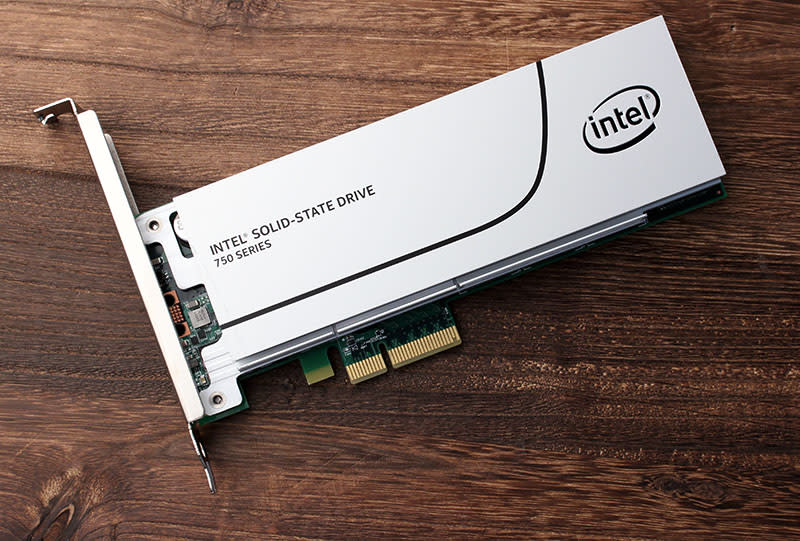
Intel has been very quiet on the SSD front for the past couple of years. After the SSD 520 Series in 2012 and the SSD 530 Series a year later, there hasn’t really been anything of note from the chipmakers. Which is strange, because Intel was one of the earliest proponents of SSDs, remember the Intel X-25M? However, Intel made a comeback to the high-end consumer SSD scene in a big way with last year’s Intel SSD 750 Series.
The Intel SSD 750 Series was one of the first PCIe-based SSD to support the new NVMe protocol, and it was made available at an accessible price (relatively speaking, of course). One unusual thing about it is that it is available in two form factors. It’s available as a standard HHHL (half-height half-length) add-in card that supports PCIe 3.0 x4 and also in a 2.5-inch form factor that connects using the new U.2 connector (previously known as SFF-8639). U.2 connectors are not commonly found on motherboards yet, so you’ll probably need an M.2 to U.2 connector if you do opt for the 2.5-inch form factor version of the SSD 750 Series.
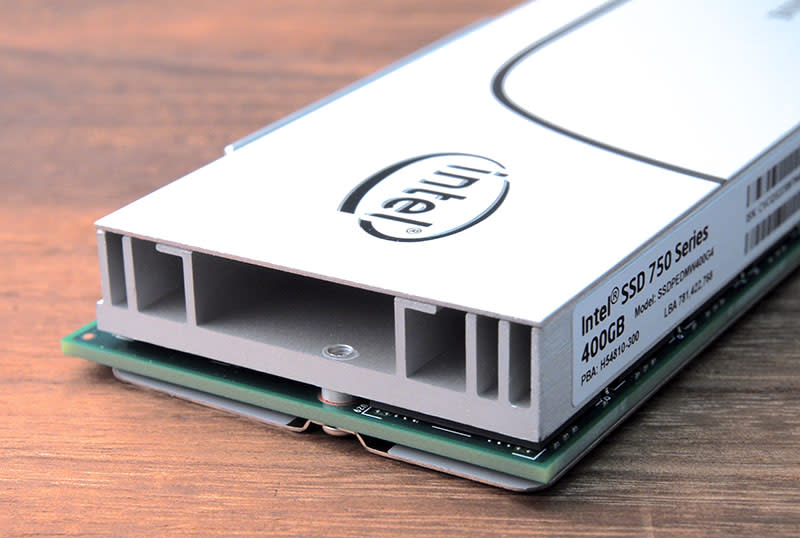
The Intel SSD 750 Series is based heavily upon the enterprise-focused SSD DC P3700, and one nifty thing that has been carried over to the SSD 750 Series is the mega 18-channel SSD Intel CH29AE41AB0 controller. The controller is Intel’s own design and the 18 NAND channel gives it a huge advantage over its competitors because most client-grade SSD controllers only have an 8-channel design.
But on the flip side, it also means high power consumption. According to figures from Intel, active and idle power draw for the smaller 400GB model can be as high as 12W and 4W respectively, with no support for DevSlp. In comparison, the 512GB Samsung SSD 950 Pro’s maximum active power draw is 7W and it idles at just 70mW. Plus, with support for DevSlp, the SSD 950 Pro can go down to as low as just 2.5mW. Fortunately, since the SSD 750 Series is likely going to be used only in desktops, this isn’t likely to be a big issue.
The NAND in use in the SSD 750 Series is Micron’s 20nm MLC NAND. The SSD 750 Series is available in 400GB, 800GB and 1.2TB capacities. The reason for this unconventional capacities is because a large amount of NAND is dedicated to over-provisioning.
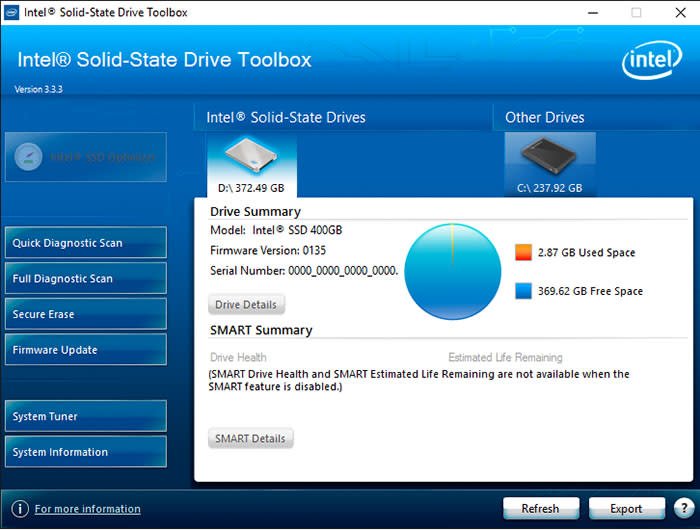
The model we have for testing is the add-in card version, and the first thing readers will note about it is its hefty heatsink, which is necessary given the drive’s relatively high power consumption. Beyond that, there’s nothing remarkable about the card, unlike some of its competitors here as you will see later. The card comes with a CD drive containing Intel’s own NVMe driver and also Intel’s SSD Toolbox utility. This utility lets users monitor and check on their drive’s status and also quickly update its firmware when they become available.
The Kingston HyperX Predator

Kingston has always been a prominent player in the flash storage business, but it has languished somewhat over the past two years. While other brands have swiftly moved on to using Marvell controllers, the Kingston HyperX Fury from 2014 still used a SandForce controller. Needless to say, it wasn’t competitive at all. Fortunately, Kingston recognized this and the later HyperX Fury switched to a more modern Phison controller and the flagship HyperX Predator that we have here has finally jumped onto the Marvell bandwagon.
The Kingston HyperX Predator supports the PCIe 2.0 x4 interface, which in turn means that performance will be slightly lower than that of the Intel and Samsung drives. While PCIe 3.0 offers about 984MB/s of bandwidth per lane, PCIe 2.0 offers only about half or 500MB/s per lane. Still, with support for four lanes, the HyperX Predator should still be a speedy drive. Sequential read and write speeds for the 480GB drive which we have here is said to be in the region of 1400MB/s and 1000MB/s respectively, which is slower than the Intel and Samsung drives, but still miles faster than the quickest SATA-based SSD.
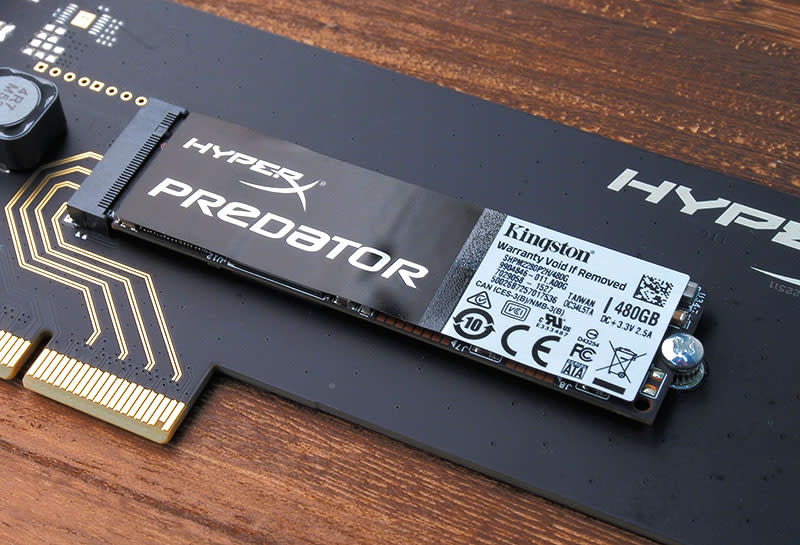
And if you look closely, you’d find that the Kingston HyperX Predator is actually a M.2 drive mounted on a PCIe adapter. This flexibility means that users can choose to use the Kingston HyperX Predator with a PCIe slot or M.2 slot.
The Kingston HyperX Predator uses the Marvell 88SS9293 controller. Codenamed Altaplus, it was Marvell’s first controller to support a four-lane PCIe interface. The NAND in use here is Toshiba’s very popular A19nm Toggle MLC NAND. The drive is available only in capacities of 240GB and 480GB. Unfortunately, this controller does not support NVMe and does not offer hardware encryption.
The drive comes with a half-height installation bracket and also a CD-key for downloading Acronis True Image, which is a useful cloning tool for those who intend to migrate their data from another drive. Unfortunately, there’s no drive management utility, but updating firmware was a cinch as Kingston provides executable files that makes updating easy.
Plextor M6e Black Edition
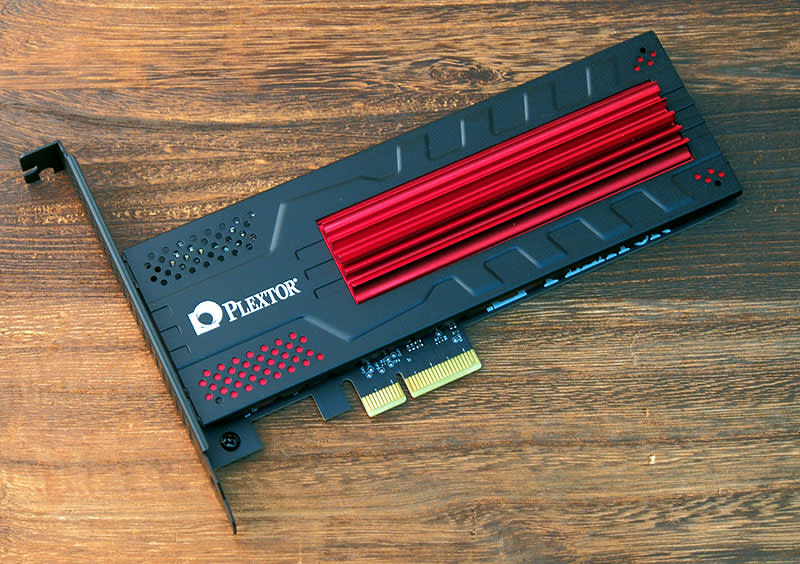
Like the other drives here, the Plextor M6e Black Edition is the company’s flagship drive. And unlike the other drives which look dull and staid, the M6e Black Edition actually manages to look quite good.
The reason for this is Plextor’s attention to detail. The entire enclosure which is in black and houses the heatsink has been given sandblasted finish, while the large bright red cooling fins provides great visual contrast. Looking around the drive we can also see LED status indicator lights, and additional 15-pin external SATA power connector and also extra pins that can be used to connect to your chassis’ HDD status indicators. You won’t find all these bells and whistles on the other drives.
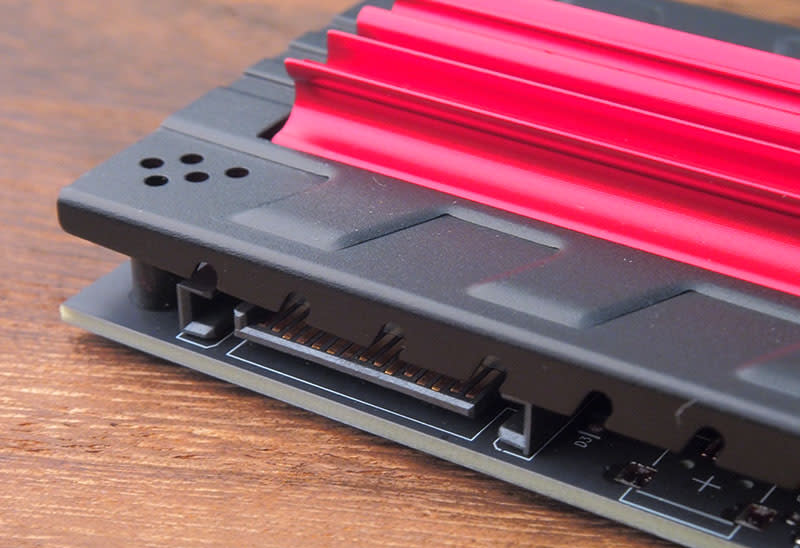
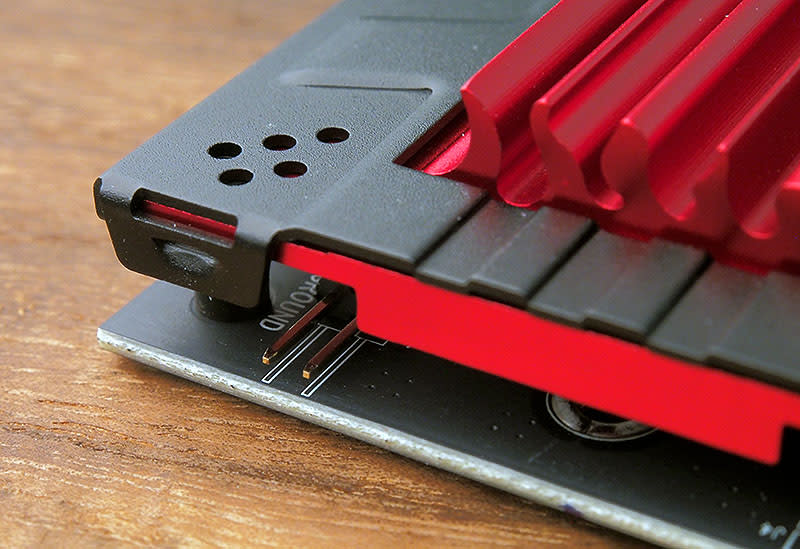
Unfortunately, most users will then be disappointed by the fact that the Plextor M6e Black Edition supports only a PCIe 2.0 x2 interface. With just two PCIe 2.0 lanes, that means a total bandwidth of just 1000MB/s, which isn’t as big improvement over SATA 6Gbps as compared to the other drives. In fact, the M6e Black Edition’s rated sequential read and write speeds for the 512GB model that we are reviewing stand at just 770MB/s and 625MB/s respectively, which is a great deal less than what the other PCIe-based SSDs that we have rounded up here can achieve.
Underneath the attractive enclosure and heatsink, the Plextor M6e Black Edition is powered by a Marvell 88SS9183 controller and uses Toshiba’s A19nm MLC NAND. And if you actually peel the heatsink off, you’ll find that there’s actually an M.2 drive underneath. In this respect, the Plextor M6e Black Edition and the Kingston HyperX Predator are actually very similar.
Luckily, the Plextor M6e Black Edition redeems itself in other ways. To begin, pre-production units of Plextor’s SSDs are rigorously tested to ensure they perform without a hitch before they can be approved for retail. This include a 100% burn-in and aging test; a 48-hour long sustained read and write test; 250 times boot cycle test; and a 4000 times idle recovery test. This explains why Plextor drives are generally regarded by many enthusiasts to be one of the most reliable around.
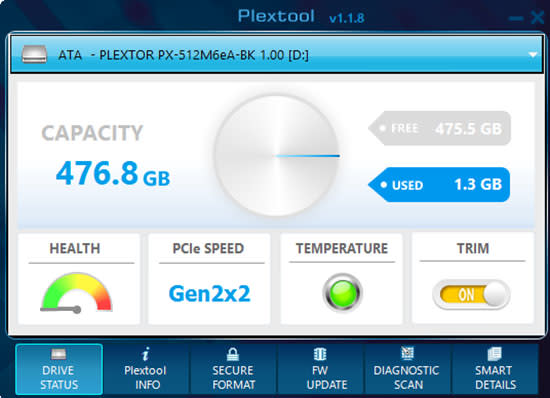
On top of that, the Plextor M6e Black Edition also supports a host of Plextor technologies, including PlexTool, PlexTurbo, PlexVault, PlexCompressor, TrueSpeed and TrueProtect. Here’s a summary of each of these technologies:
PlexTool - A utility to manage and monitor your drive, as well as to help update the firmware.
PlexTurbo - A caching technology that uses system memory to dramatically boost performance.
PlextVault - A security feature that lets you store and hide data from others, which is useful if your system is shared with others.
PlexCompressor - Automatically compresses data to give user’s more free space.
TrueSpeed and TrueProtect - The former helps sustain performance levels even as the drive runs low on capacity, while the latter is a multi-layered error checking mechanism and provides 256-bit AES encryption.
The final thing to note for system builders is that drive does not come with a half-height bracket, and only comes with mounting screws.
PCMark 8
PCMark 8 is the most up-to-date system benchmarking software from benchmarking specialists Futuremark. It was designed for Windows 8 machines and the storage suite test puts drives through a collection of 10 different real life workloads involving applications such as Photoshop, Illustrator, InDesign, Word, Excel and even games like Battlefield 3 and World of Warcraft.
On PCMark 8, the final scores of the drives were pretty close, with the Samsung SSD 950 Pro taking a narrow lead with a score of 5095. Unsurprisingly, since the Plextor M6e Black Edition only supports PCIe 2.0 x2 interface, it managed the lowest score of 5013.
Looking at the actual speeds recorded, we can see that the Samsung drive was actually the fastest by a considerable margin, racking up 667.51MB/s. This was a good 39% faster than the second-placed Intel SSD 750 Series. In turn, the Intel drive was about 40% faster than the Plextor M6e Black Edition and Kingston HyperX Predator, which managed very comparable speeds of around 335MB/s.
Looking at the timing breakdown, we can see that the Samsung SSD 950 Pro was the fastest drive in all workloads.

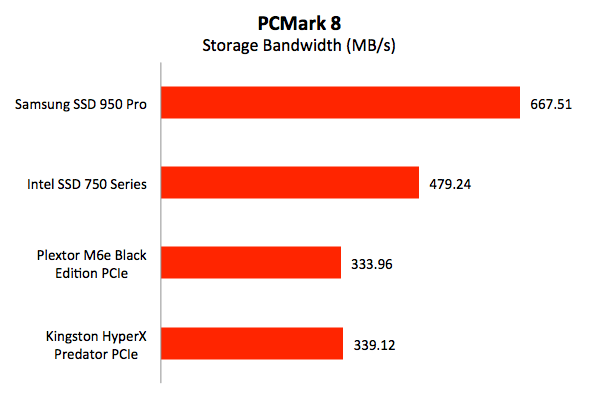

CrystalDiskMark 5.0.2 Results
CrystalDiskMark is an easy-to-run and quick utility to use to gauge a drive’s performance. It measures sequential read and write performance and random read and write speeds of random 4KB and 4KB (queue depth 32) data.
It was a pretty close fight between the Samsung SSD 950 Pro and Intel SSD 750 Series in the sequential read and write workload, but the Intel came out ahead by around 10% overall. The Kingston HyperX Predator didn't fare too badly; its write performance was commendable as it was only some ways off the Intel drive and it handily beat the Samsung drive. The Plextor M6e Black Edition was hampered by its slow interface and wasn’t exactly competitive in this workload.
Moving on, the Samsung SSD 950 Pro exhibited very fast read speeds in the following 4K and 4K (32 queue depth) work scenarios. However, its write speeds weren’t as impressive, especially on the more intensive 4K, 32 queue depth workload where it managed just only about half the speed of the Intel SSD 750 Series. On these two workloads, the Kingston HyperX Predator and Plextor M6e Black Edition drives weren’t a match at all. Still, the Kingston drive has the consolation of being comfortably quicker than the Plextor drive.


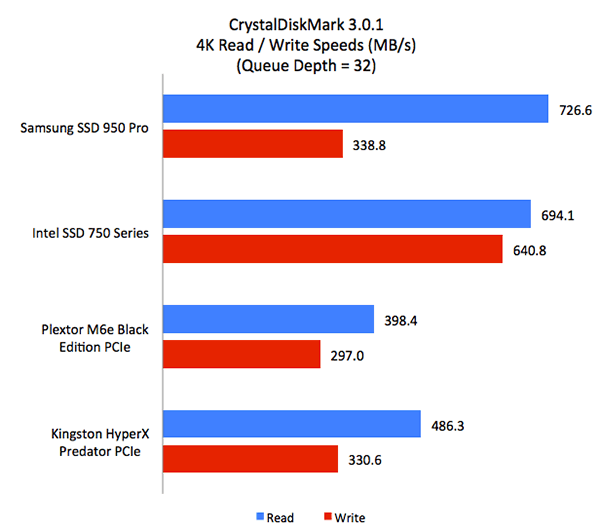
AS SSD 1.8.5636.36856 Results
AS SSD is a benchmark that uses non-compressible and completely random data. This benchmark is useful because some controllers, like the once popular but now defunct SandForce SF-2281, compress data first before moving them around. However, with non-compressible and random data, controllers cannot compress the data first, which forces them to deal with data as they are. Therefore, this is a useful benchmark to prevent drivers using controllers like the SF-2281 controller or similar from gaining an upper hand.
Beginning with AS SSD’s Copy Benchmark, we can see that the Samsung SSD 950 Pro and Intel SSD 750 Series was, once again, evenly matched. However, the Kingston HyperX Predator managed to surprise us with its very good performance on the ISO copy test. Unfortunately for the Plextor M6e Black Edition, it just wasn’t very competitive with its limiting PCIe 2.0 x2 interface.
Sequential read and write performance was just about neck and neck between the Samsung and Intel drives, but as we move to the 4K and 4K, 64 queue depth workloads, we can see that the Intel SSD 750 Series managed to get the upper hand. The Intel drive’s performance on the intensive 4K, 64 queue depth workload was impressive as read speeds were 33% higher while write speeds were a staggering 287% greater than the Samsung drive.




ATTO Disk Benchmark 3.0.2 Results
ATTO is one of the oldest benchmarks around, but it’s still a useful tool to gauge a drive’s adeptness at managing compressible data. It’s also useful for seeing how a drive performs across a variety of different transfer block sizes
The Samsung SSD 950 Pro was easily the top performer on the ATTO benchmark. Even while handling small 4K data blocks, it was quick and fast. The Intel SSD 750 Series, on the other hand, exhibited poor read performance on the smaller 4K and 32K workloads. The Kingston HyperX Predator demonstrated pretty good performance as it started ramping up as soon as we came to 32K work load. Sadly, the Plextor M6e Black Edition failed to compete because of its restrictive PCIe 2.0 x2 interface.


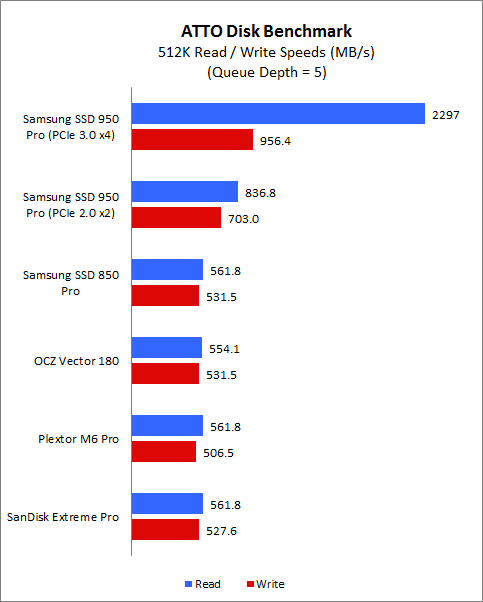

Iometer Results (Part 1)
Lastly, we put the drives through the rigorous grind of Iometer, with different workloads and I/O queue depths. We have chosen to show results from a queue depth of 1 to 5 as this better represents the workloads a typical consumer might face. The Samsung SSD 950 Pro was dominant on Iometer. It came out tops for all workloads, apart from the 64K streaming write workload where it went Intel’s way. Looking at the graphs, we can also see that the Samsung and Intel drives are significantly quicker than the Kingston and Plextor drives. One interesting thing to note is the Kingston HyperX Predator’s very strong showing on the 64K streaming writes workload. The Plextor M6e Black Edition didn’t fare too poorly despite its limited interface.
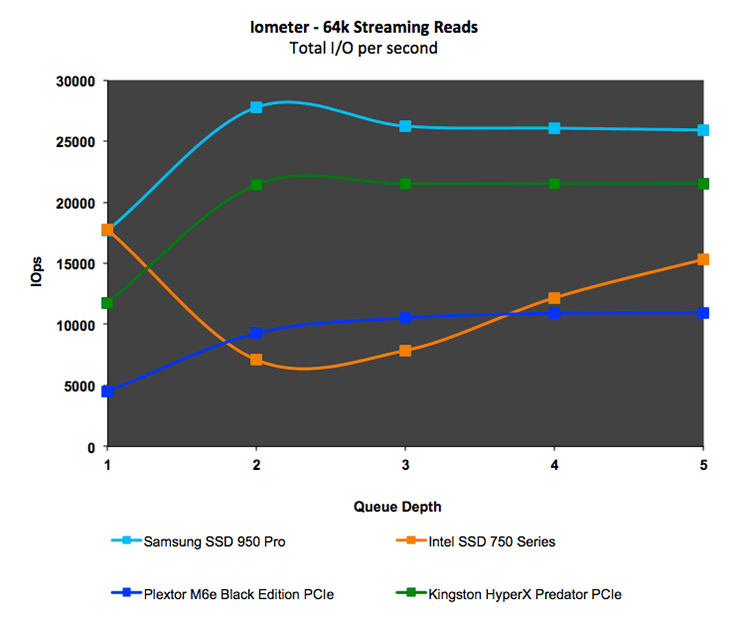
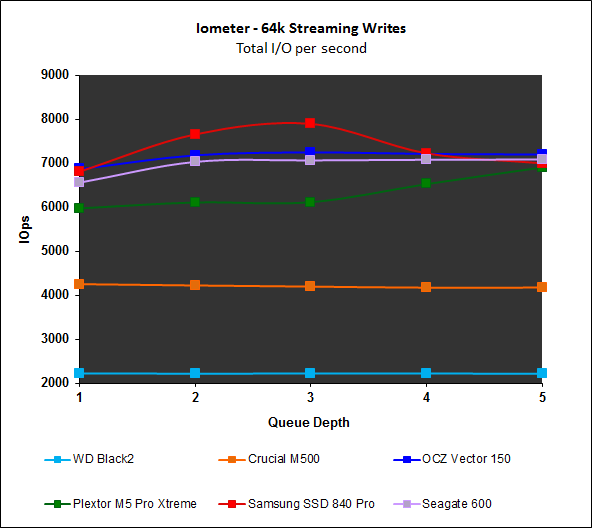


Iometer Results (Part 2)
Finally, we look at the I/O response times for the workloads reported on the previous page. No surprises here as the Samsung and Intel drives recorded the quickest response times in all workloads, which explains the high IOPs that the two drives recorded earlier.
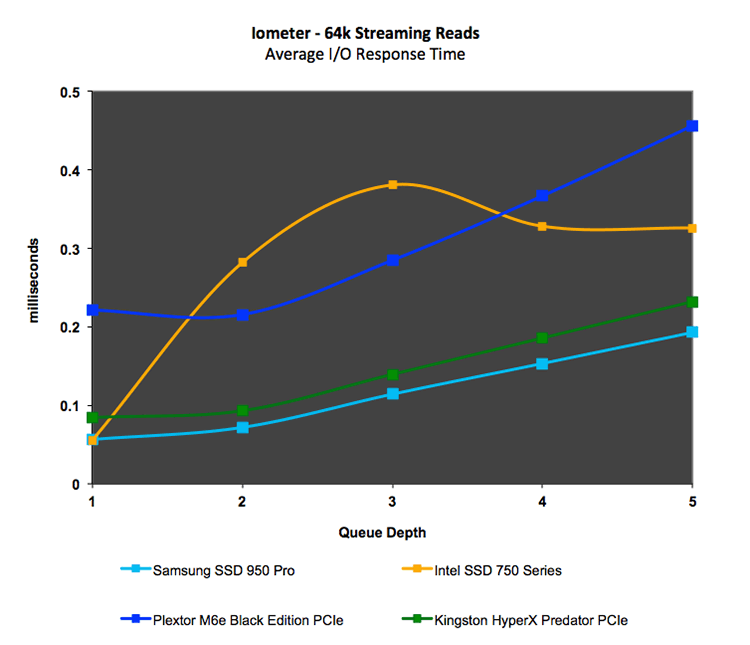
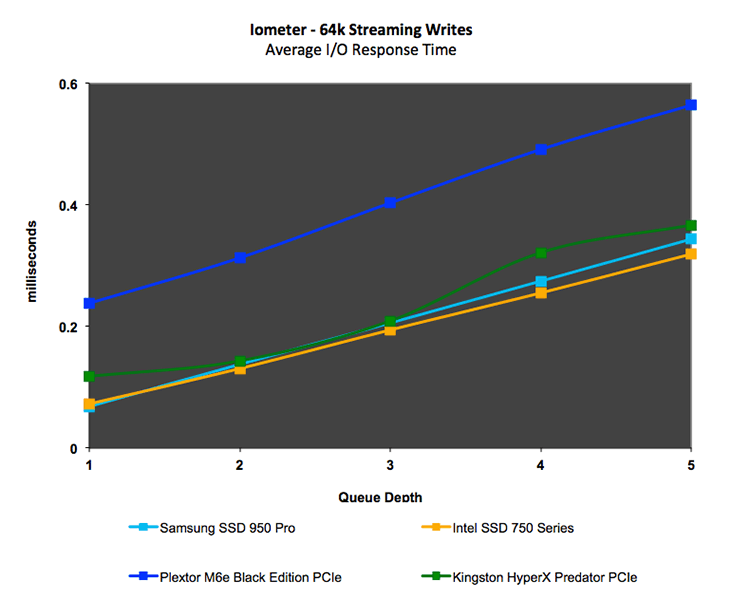
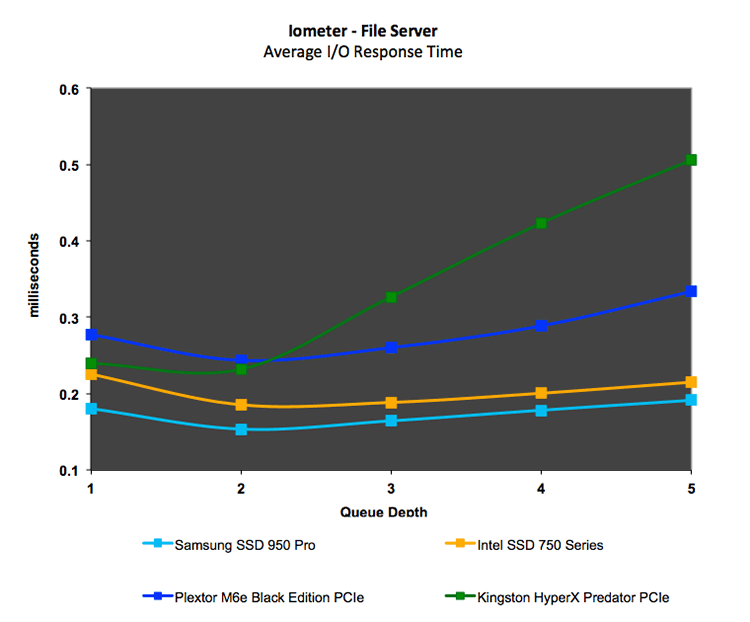
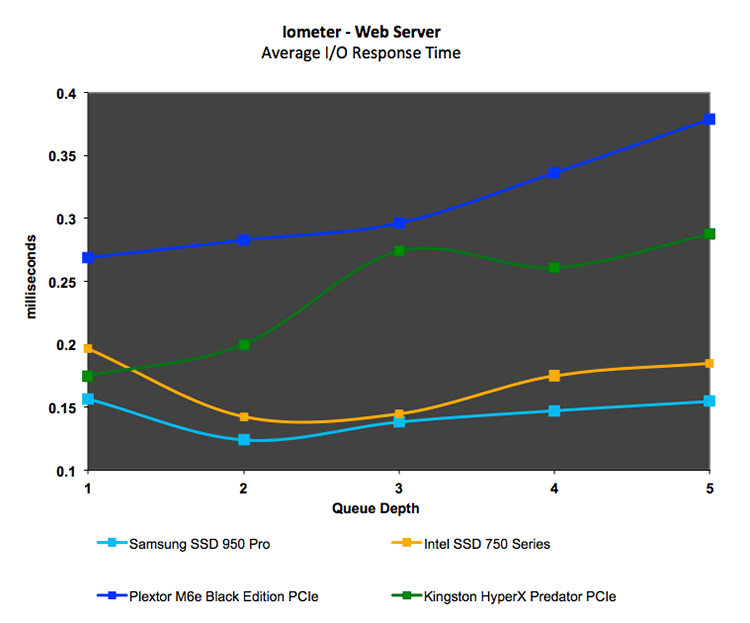
PCIe is the future
Looking at the results of the four PCIe-based SSD tested, there’s no doubt that PCIe-based SSDs are the future for SSDs. While most SATA-based SSDs top out at around 530 to 550MB/s, these PCIe-based SSDs can go as high as 2200MB/s. Performance at high queue depth scenarios are also greatly improved, thanks to the higher bandwidth interface and support for the lower latency NVMe protocol.
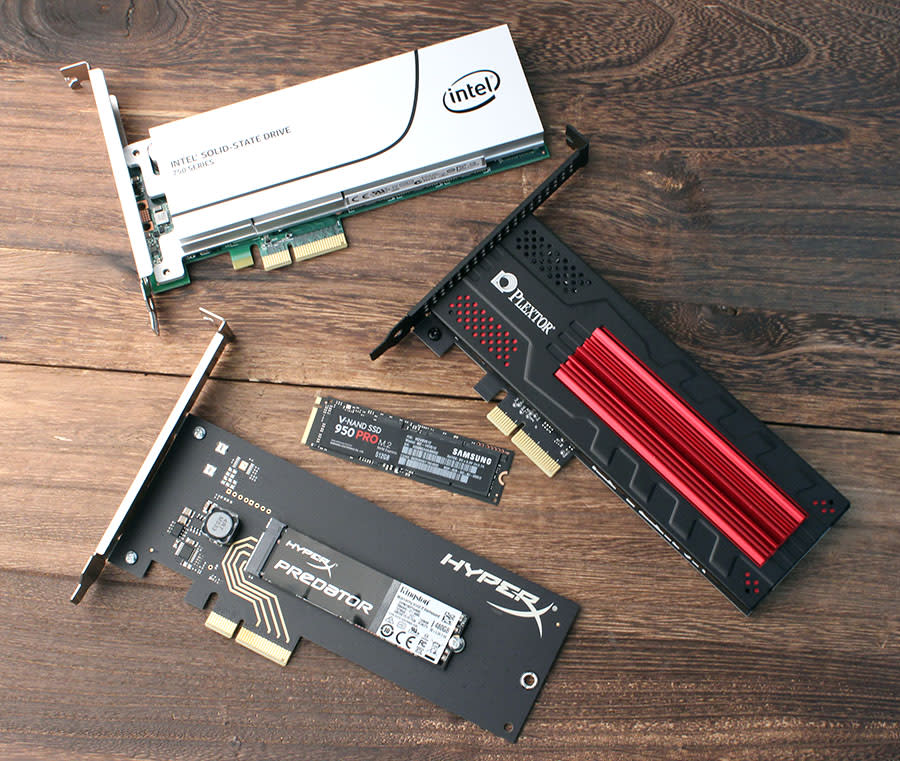
That said, there are a couple of things to look out for and that’s the PCIe interface that the drive supports. As our results show, the interface that the SSD supports plays a big role in determining performance. With that in mind, the Intel SSD 750 Series and Samsung SSD 950 Pro are presently two of the fastest drives around as they support the PCIe 3.0 x4 interface. Support for NVMe is also a plus, but the protocol still seems a bit unreliable at this point. As noted in our earlier review of the Samsung SSD 950 Pro, Window 10’s support for NVMe is still not quite up to the job at this point, which in turn resulted in very disappointing performance. To maximize performance would therefore require falling back on manufacturer’s own drivers, but even then performance can still be underwhelming. Even so, it should be only a matter of time before these issues get ironed out as the NVMe protocol matures and becomes more widely adopted.
The Winner is..
Samsung has been the dominant in the SSD industry and enjoys a market share of around 35%. Thanks to advances like 3D V-NAND and its aggressive pricing strategy, it is little wonder that many OEMs and enthusiasts around the world turn to Samsung when it comes to outfitting their devices with an SSD.
Unlike the Samsung SSD 850 Pro from 2014, the newer Samsung SSD 950 Pro is evolutionary rather than revolutionary. Nevertheless, it shouldn’t diminish the fact that the SSD 950 Pro is one blazing fast drive and that the company should be proud of it for winning our high-end PCIe-based SSD shootout.
Thanks to its support for the PCIe 3.0 x4 interface, fast V-NAND, and powerful controller, the SSD 950 Pro was the top performer overall. However, it wasn’t as dominant as its predecessor - the SSD 850 Pro - which easily wiped the floor with the competition thanks to its stellar performance. The SSD 950 Pro was at times troubled by Intel’s SSD 750 Series, but it managed to hold on to the speed crown by a narrow margin.
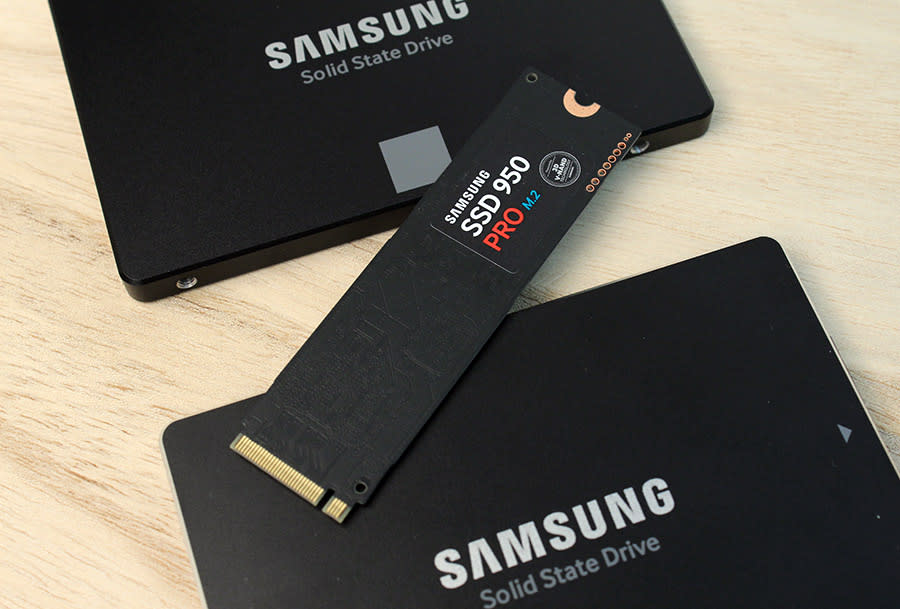
Although overall performance is blistering, we can see that it does suffer from some write performance issues where its numbers were much below expectation. Our guess is that the NVMe drivers aren’t working optimally yet and still has issues that need to be ironed out. But apart from this, there’s little else to fault the drive. It offers high performance, hardware encryption, ease-of-use, and all in an unbelievably small form factor. The icing on the cake, however, has to be its rather sensible asking price of S$599, which makes the 512GB SSD 950 Pro an easy drive to recommend to hardcore system builders who want to splurge on the best.
The Intel SSD 750 Series marked Intel’s return to the high-end consumer SSD scene and what a comeback it was. Thanks to the fast and powerful custom Intel controller, support for PCIe 3.0 x4, and NVme, the Intel SSD 750 Series could go toe-to-toe in the SSD 950 Pro for the most part and could even beat the Samsung SSD 950 Pro in certain benchmarks. It’s also quite reasonably priced at S$609 for a 400GB drive. Our main gripes with the SSD 750 Series is that it does not support hardware encryption, has high power consumption, and that it is only offered as an add-in card or 2.5-inch drive that supports the new U.2 connector, which could make it cumbersome to install in some systems.
The Kingston HyperX Predator is a bit of a surprise package for us, because despite its support for only the PCIe 2.0 x4 interface, it was still pretty fast. In fact, it was in some instances almost as quick as the Samsung SSD 950 Pro and Intel SSD 750 Series. We also like the fact that it’s really just an M.2 drive planted onto an M.2 to PCIe adapter. This gives users greater flexibility to setup their system, especially for users with M.2 slots and require their PCIe slots for other components such as graphics cards, network adapters or even sound cards. That said, while the drive does offer good performance, it is pretty barebones as it does not support hardware encryption and there’s no utility to configure, manage and monitor the drive. Nevertheless, with a price of around S$573 for the 480GB drive, we think the HyperX Predator is really for penny pinchers as it's hardly cheaper than the Samsung SSD 950 Pro.
Despite the Plextor M6e Black Edition’s exciting looks and design, it failed to win us over mainly because of its limiting interface. As we mentioned earlier, the difference in bandwidth that PCIe 3.0 x4 interface provides over the Plextor drives’ PCIe 2.0 x2 interface is simply too great. As a result, it wasn’t a surprise at all to see that the Plextor M6e Black Edition struggling to compete in terms of performance. On the flip side, the M6e Black Edition is a handsome drive and has some nifty features such as the pins that connect to the chassis’ LED status indicators. But with a retail price of S$639 for the 512GB model - which is the greatest here - it will take more than these features to keep the Plextor M6e Black Edition competitive.
Criteria/Model | Intel SSD 750 Series | Kingston HyperX Predator | Plextor M6e Black Edition | Samsung SSD 950 Pro |
|---|---|---|---|---|
8.5 | 8.0 | 6.5 | 9.0 | |
7.5 | 7.5 | 9.0 | 8.5 | |
8.0 | 7.5 | 4.0 | 8.5 (adjusted upwards from 8.0 in original review) | |
8.0 | 7.5 | 6.5 | 8.5 | |
S$609 | S$573 | S$639 | S$599 |
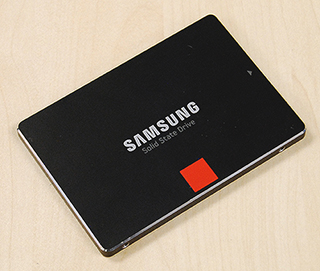 |  |
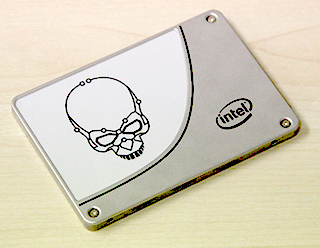 |  |
 |  |
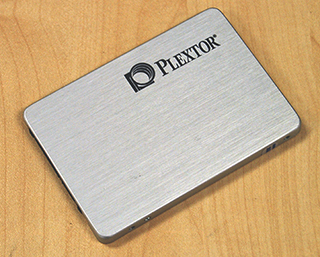 |  |




